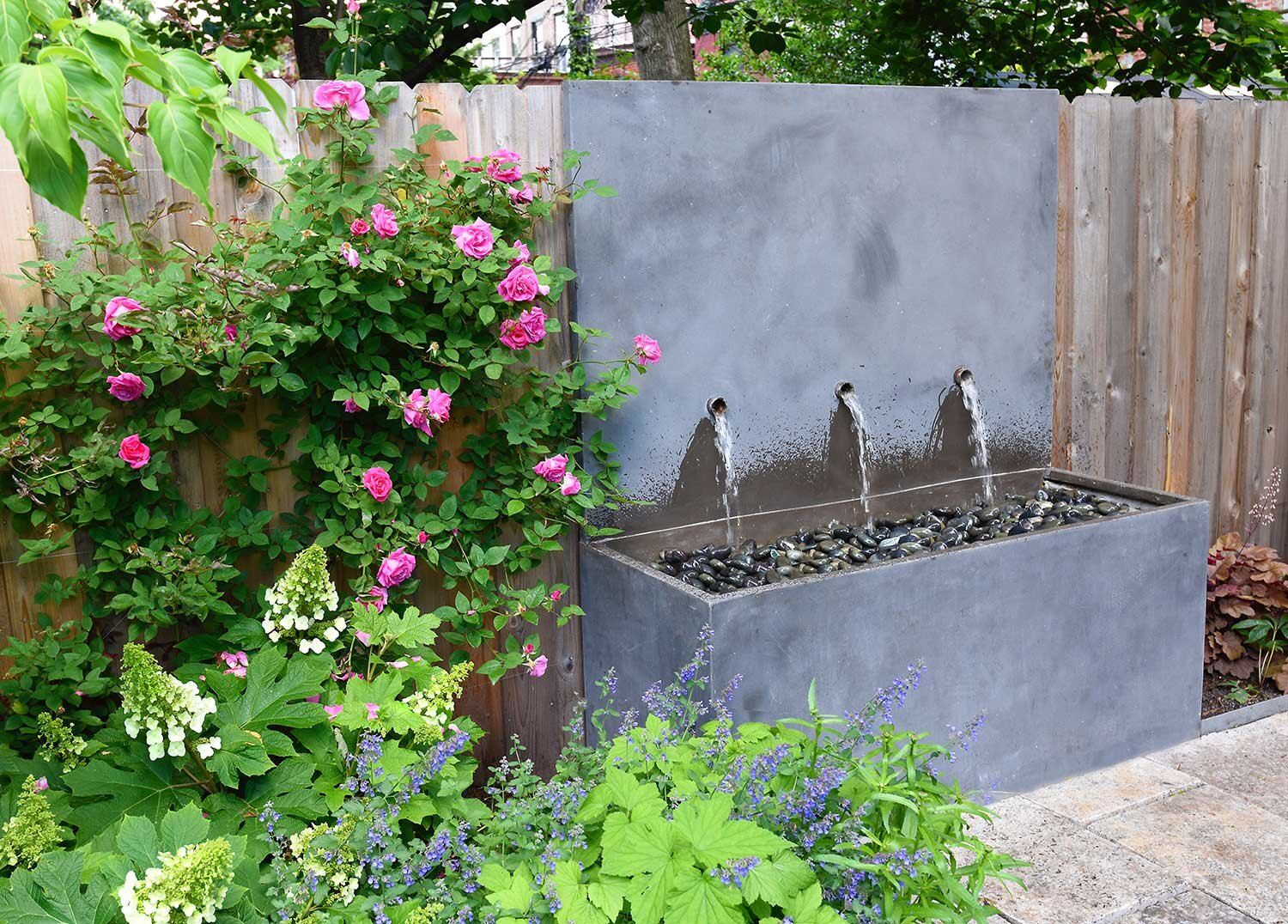More so than other arts, garden and landscape design can summon all our sensual responses.
Scent and Sound are Emotional Triggers
Designing a garden is a challenging undertaking, particularly within the constrained dimensions of a small, urban New York City garden.
Adding elements and details that excite our senses beyond just sight, adds complexity to the garden experience. Designing a garden considering olfactory and audible tools, (scent and sound) are often forgotten devices at the designer’s disposal.
Using Sound in Landscape Design
In landscape design, scent and sound are mechanisms that can assist in creating powerful triggers of emotion, memory, and imagination. We can think of countless possible recollections… perhaps a few might be the fragrance of Korean spice viburnum (Viburnum carlesii) along a garden path in spring, the scent of Boxwood (Buxus) baking in the June sun or the perfumed air surrounding Summersweet (Clethra alnifolia) in July. How about the crunching noise of pea gravel under your feet evoking a cottage garden, decomposed gravel transporting one to the formality of a French garden? The memory elicited is uniquely personal and connected to elements that one associates to a formal, native or cottage garden. “Sensory experiences and the senses themselves are culturally bound” according to anthropologist Constance Classen. (Elizabeth Hyde, “The Scent of Power”)
Music in the garden
Louis XIV instructed musicians to follow him around the Versailles gardens playing their instruments - additionally they were to keep out of sight and at a distance, hidden behind tall hedges. The video above is a replication of Louis XIV extravagance. Please play with volume ON!)
Most homeowners don’t have these capabilities, but they can lure “other musicians” — songbirds into their small enclosed gardens and listen to an aviary chorus. Attract sound by choosing native plants and designing to attract birds into the garden. The sounds of songbirds are most striking in the morning and late afternoon - hence the term “the morning chorus” as defined by the Audubon society.
From Italian renaissance gardens to American prairie gardens, designers have found ways to lure songbirds into the garden exploiting their musicality.
Materiality in the garden
Less obvious than a water feature is the sound of gravel or a light aggregate beneath your feet. Pea gravel, deconstructed granite or seashells are an easy surface to maintain in the garden. Using sense-provoking materiality such as gravel in an enclosed garden (reminiscent of cloister gardens) provides an auditory soundtrack to the ritualistic activity of walking and contemplation.
Tiny Brownstone garden in Brooklyn with seashells as ground cover.
Water features in the garden
The natural sound of water is a key element including in custom rooftop gardens, where compact water features add both sound and serenity and considered music in classic Chinese gardens. Keeping the water source visually hidden, eliminating the visual reference and highlighting the auditory creates mystery and forces the garden visitor to expand their sensory experience. In a small garden try a recirculating water feature. The drip, drip drip, or gurgling sound will act as a white noise to mitigate sounds from neighboring yards, relax you and your guests. A secondary benefit will be the fountain’s ability to cool the surrounding air.
What’s a “Budbude?”
Mughal gardens celebrated their respective nature through the acknowledgment of the water in the garden. The chahar bahr was designed around the four flowing rivers, “pavilions were constructed in other gardens because it provided shelter from the rain yet welcomes the sensory experience of nature inside.”1 (Priyaleen Singh, Sounds and scents of Monsoon in the Late Medieval Gardens of Rajasthan). At other times in gardens where water was scarce, a “budbude” was created. (Budbude is roughly translated to mean “bubbling.’) A budbude could be a system of pipes forcing water to “bubble-up” through a small perforated slab placed over a water basin, or.. A small pond with perforated pipes below the surface forcing up tiny air bubbles. Essentially, the activation of water creates sound.
Rain Chains in the Garden
Much as the experience of the monsoon in 18th-century gardens designed on the Indian subcontinent found ways to design with nature. Japanese gardens also found ways to honor the rainstorms in the garden with rain chains.
These rain chains originated in Japan where they have been used for hundreds of years to collect water from rooftops. The rain chain guides water downward through chains into large barrels for household water usage. In Japan they call them “Kusari Doi” which literally means chain gutter. Present homeowners can borrow that lesson to design their side yards, rear gardens on small plots adjacent to their home. Sitting on a covered porch or next to an open window during a spring shower, a rain chain is a decorative and functional alternative to traditional, closed gutter downspouts. Guiding rainwater visibly down chains or cups from the roof to the ground, rain chains transform a plain gutter downspout into a pleasing water feature. From the soft tinkling of individual droplets to the soothing rush of white water, they are a treat to listen to.
Using water chains in landscape design.
More so than other arts, garden and landscape design can summon all our sensual responses.
Gardens, plantings, landscapes can be designed to stimulate all our senses, beyond just visuals.



